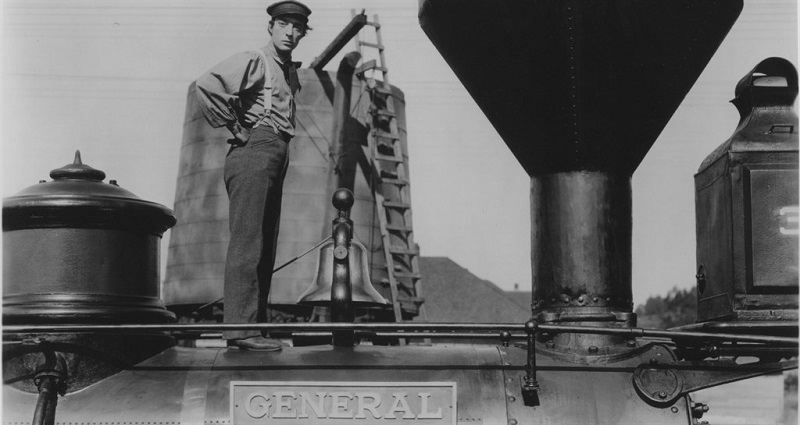GREAT BUSTER, THE: A CELEBRATION
director/writer: Peter Bogdanovich; cinematographer: Dustin Pearlman; editor: Bill-Berg-Hollinger; music: Mont Alto Motion Picture Orchestrata; cast: Peter Bogdanovich (Narrator), James Curtis; Runtime: 102; MPAA Rating: NR; producer: Charles S. Cohen/Louise Stratten/Roee Sharon/Peter Bogdanovich; Cohen Media Group; 2018-B/W)
“Would make a welcome addition to any film library on the Old Stone Face for both newcomers and those already familiar with him.”
Reviewed by Dennis Schwartz
The enthusiastic Buster fan writer/director/co-producer/narrator Peter Bogdanovich (“The Last Picture Show”/”What’s Up, Doc?”) gives us this luminous b/w documentary on the great physical and inventive comedian Buster Keaton, considered in the industry by most as second only to Charlie Chaplin in the silent film era of comedians.
The film is outstanding in the third act when it shows clips of Buster’s ten masterpieces he starred in and created from 1923 to 1928 (Three Ages, Our Hospitality, Sherlock Jr., The Navigator, Seven Chances, Go West, Battling Butler, The General, College, Steamboat Bill). With the Civil War comedy, The General (1926), considered by many critics the best film he made. It’s ranked high on the list of the best films ever (and has been called by the experts the best comedy ever made).
The conventional documentary lags when it has a bevy of talking heads (friends, celebrities and collaborators) interviewed and gushing over Buster. I could have easily done without their comments (most told me nothing I didn’t already know and killed the film’s rhythm), even if they were sincere. Though I did find the input of film scholar James Curtis both meaningful and intelligent.
Besides the wonderful photographs and the stunning restorations of his archival works, the film gleefully traces Buster’s life (born in 1895, in Piqua, Kansas) and his accomplishments. It even touches on his misfortunes (like making the biggest mistake of his life by listening to his brother-in-law Joseph Schenck, who was the producer of the indies that gave him his big break in films, and in 1928 talked him into taking the big bucks from the MGM studio but thereby giving up creative freedom to work in talkies in the 1930s. MGM is a studio known for good reasons as a graveyard for talented comedians.
It was fun seeing film clips of Buster as an infant acting with dad and mom in their traveling vaudeville act at the turn of the last century, where dad used him as a pratfall to get laughs (using a suitcase handle that was sewn into Buster’s clothing to help when tossing him around the stage). It tells how he met Fatty Arbuckle in NYC and was mentored by him to make two-reelers in Long Beach, California, thereby leaving his vaudeville act in 1917 when he was 21 to begin a new career in film.
The film traces his drinking problems when frustrated at MGM, his divorce from his actress wife Natalie Talmadge and how he fully recovered and was sober in the 1940s. And though no longer a star–he was a humble gag writer at MGM, made a comeback doing two-reelers for Educational pictures in 1934, became an inspiration to other actors, played in modern film cameos (for example in the 1965 youth film Beach Blanket Bingo) and never lost his dignity. He finally met the right wife in the dancer Eleanor Norris and enjoyed the last fourteen years of his life working on television commercials and on films. In 1966, at 70, suffering from a terminal illness, he died while playing bridge with friends.
Even if this film might not measure up to the 1987 three-part series “Buster Keaton: A Hard Act to Follow,” it’s a funny film and would make a welcome addition to any film library on the Old Stone Face for both newcomers and those already familiar with him.

REVIEWED ON 5/29/2020 GRADE: A-